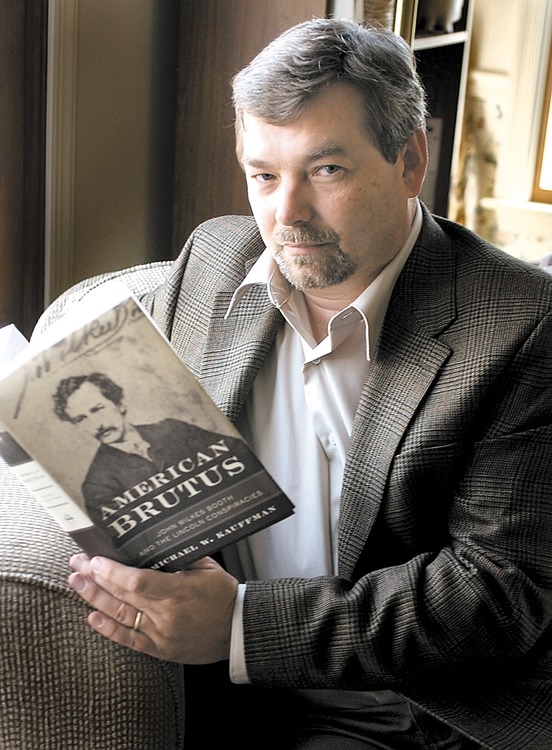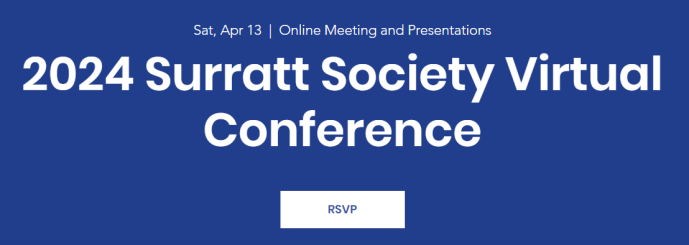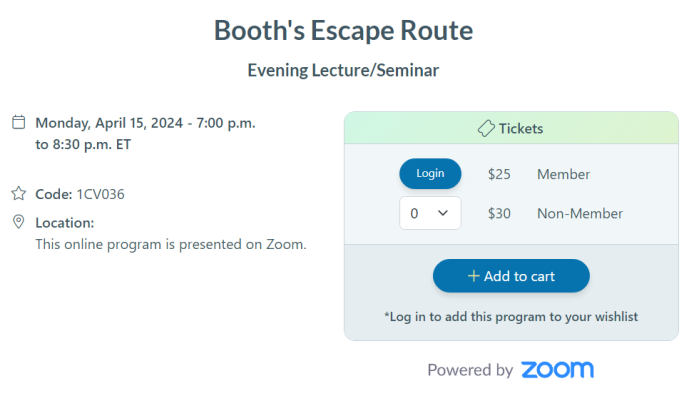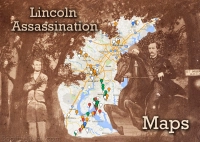In addition to being a school teacher, I also have a part time job giving tours at Historic Port Tobacco Village in Charles County, Maryland. Port Tobacco is the original county seat of Charles County with a long and multifaceted history. The village also plays into the Lincoln assassination story due to George Atzerodt’s residence there and Thomas Jones being offered $100,000 for Booth’s whereabouts in a Port Tobacco hotel. It’s a nice spot to visit and learn some history.
Today, I was fortunate enough to give a tour to a group of four retirees from Pennsylvania. They were in Maryland to visit some of the Booth escape sites which means we got along swimmingly. I provided them insight into the Confederate leanings of Maryland during the Civil War and how Southern Maryland was a hotbed of Confederate sympathizers which worked in Booth’s favor. As we went on, the group asked me about the recent events in Charlottesville and the ongoing removal over Confederate monuments. This was the first time I had been asked to share my opinion about it in public.
I am not someone who shies away from or avoids the uncomfortable or dark parts of our history. I spend most of my time investigating and researching the individuals who murdered our 16th President. Though I am not a professional historian, I always try to look at things with a historian’s eye and understand the context of an event.
And so, with that historian’s perspective, I told the group my heartfelt opinion. The Confederate memorials in our country’s cities should come down. It is not only the right thing to do morally, but also historically.
I’d like to expand on the statement above by addressing some of the reasons I have come across regarding people’s reasons for wanting the Confederate memorials to remain.
1. “What’s the big deal? It’s just a statue.”
A great many people might have this sort of reaction when discussing the removal of Confederate memorials. It derives from either a lack of knowledge on the subject or from a view of “It doesn’t bother me so it shouldn’t bother you.” The former situation can hopefully be remedied by educating oneself about what the the memorials represent. The latter situation speaks to an individual’s inability to empathize and consider the feelings of others. You may not be personally offended by a statue of Jefferson Davis or Robert E. Lee, but one would hope it would not be difficult for you to see why others might be offended. As I teach my third graders, it is important that we attempt to put ourselves in the shoes of people different from ourselves and consider their feelings and points of view. When it comes to the Confederate memorials, it is imperative for white Americans who question the need to remove these pieces to see these statues through different eyes. How would you feel about walking by and seeing these statues if your ancestors were brought over to this country on slave ships and forced into generations of servitude? Or, as a person of color in this country who has to deal with both random and institutionalized acts of racism each day, how would you feel seeing these figures, who fought for white supremacy, in prominent positions in front of your local government buildings? One would hope that morality, understanding and compassion alone would make a compelling case for why these memorials deserve to be removed.
2. “You are erasing history”
This is among the most common reaction I have seen from people who are in favor of keeping the Confederate memorials, despite the moral objections to them. This view holds that the monuments are pieces of history and that they should remain since they represent our past. Some proponents of this view are able to admit that these statues represent a shameful part of our past, but that they still deserve to stay. While, on the face of it, this seems like a reasonable enough opinion, the truth of the matter is that these memorials do not represent the history that the proponents of this view think they do.
Perhaps the thing that has bothered me most in the recent days has been seeing those I considered educated historians fall into the trap of believing that these monuments represent benign figures of history. Below is a wonderful graphic put together by the Southern Poverty Law Center regarding when most of our nation’s over 1,500 public statues and memorials to the Confederacy were erected.

Please click to enlarge
According to the SPLC, “The dedication of Confederate monuments and the use of Confederate names and other iconography began shortly after the Civil War ended in 1865. But two distinct periods saw significant spikes. The first began around 1900 as Southern states were enacting Jim Crow laws to disenfranchise African Americans and re-segregate society after several decades of integration which followed Reconstruction. It lasted well into the 1920s, a period that also saw a strong revival of the Ku Klux Klan. The second period began in the mid-1950s and lasted until the late 1960s, the period encompassing the modern civil rights movement.”
The correlation should be evident and speaks to the true purpose of these memorials. The monuments that are coming down were never intended to be benign representations of Civil War history as some would like to think of them. The erection of these statues were direct responses to the efforts of bringing about racial equality and, when viewed in that proper context, we can see the perception of these memorials as being symbols of white supremacy far more accurate then them being symbols of the past. The only history these memorials represent is one of white supremacy, and sadly their removal will not do anything to erase that part of our history or present.
I think it’s important for us to note that the memorials being removed are not historic markers on Civil War battlefields or educational panels inside of museums. Nor are people calling for the destruction of Confederate graves or headstones. The graphic above does not count the, “approximately 2,570 Civil War battlefields, markers, plaques, cemeteries and similar symbols that, for the most part, merely reflect historical events.” As far as I am aware, there have been no calls to shut down the Gettysburg battlefield, stop teaching about the Civil War in schools, or disinter Confederate dead. The Civil War is not going to be forgotten by the removal of these memorials. If you truly feel that that removing these statues will result in the “erasing of history”, I would like to point out to you that there are millions of articles, pamphlets, books, magazines, journals, dissertations, exhibits, maps, songs, documentaries, websites, etc, written about the Civil War that will teach you far more about history than a Jim Crow era statue to white supremacy ever could.
3. “Robert E. Lee (or any other Confederate name) also did a lot of positive things for the country, too.”
I’ve certainly seen this argument. The idea is that the people on the memorial pedestals may have expressed views contrary to the Confederacy, acted with honor, were well respected, helped to bring the nation back together after the war, or contributed to America in other ways. This view holds that it is not fair for statues of these figures to be condemned just for “wearing the Gray”. This is an interesting point of view that I’d like to explore.
Using this view, I would like to propose that a new Civil War statue be placed in D.C.. The figure for the statue would be a man who, in the midst of the secession crisis wrote, “I believe in country right or wrong, but gentlemen the whole union is our country and no particular state. We should love the whole union and not only the state in which we were born. We are all one people, and should have but one wish, one object, one heart.” This man, so against secession, was described personally by his peers as, “a manly man; a term not easily defined, for there are those, blessed by nature, who have lacked the qualities of manhood. [He] was not one of these; he was firm as a rock, honest, sincere, and unassuming in his private associations. If he had not a good word, he never used a bad one, to friend or foe; yet he never brooked an insult or pocketed an affront. Young, impetuous, fearless, true, he was also kind, loving, and sympathetic; he could wile away hours playing with children, like a big boy (he often did so with mine) and the next moment, he was a man among men. His word was his bond, and men that knew him never doubted it.” Lastly, my proposed figure, a man who opposed secession and was so admired by his friends, was described as a “genius” by newspapers nationwide. “The hackneyed term, talent, cannot be used in speaking of this young [man] of such wonderful promise. It is genius in the broadest and largest acceptation of the term.” Doesn’t the man described above sound worthy of a possible memorial? Based on the side of these view points, the answer would certainly be, yes. And yet when I tell you that the man I have described is John Wilkes Booth, the assassin of Lincoln, does it still seem like a good idea to place a memorial to him? Decency would hopefully compel you to say no, but why is that so? It is very much true that John Wilkes Booth opposed secession originally and found himself in trouble while performing in Montgomery, Alabama due to this pro-union view. Booth was loved and respected by practically every single person he interacted with. He was notably fond and good with children. His genius on the stage made it so that Booth was considered one of the country’s greatest actors. Yet, despite all of John Wilkes Booth’s positive attributes one would never put up a statue of him in a public square because he chose what his legacy would be when he shot Abraham Lincoln.
The same can be said for Lee, Jackson, Davis, and all of the Confederate officials. No matter what they may or may not have personally felt about issues like slavery, when they made their choices to fight against the Union, they surrendered their legacies to that of the Confederacy. While one is free to explore the complex histories of these figures, in the same way that this blog explores the histories of those connected in Lincoln’s death, nothing you can find will ever unravel these figures with the cause they sided with. All of the men featured on the memorials that are coming down chose the legacy of siding with the Confederacy. And, lest we forget, the Confederacy’s reason for existing was the perpetuation of racial based rape, torture, and genocide, otherwise known as slavery. That is the legacy of the Confederacy and those who fought to support it.
4. “Of course slavery was wrong but lots of people owned slaves. Are you going to target George Washington and Thomas Jefferson next because they were slave owners?”
Perhaps the most desperate of all of the reasons to keep the Confederate memorials is the above “slippery slope” analogy. It attempts to equate pre-Civil War slave owners such as Washington and Jefferson with the slave owning Confederates. It usually follows that, if we are to remove these Confederate statues, when will it end? Are we going to tear down Mount Vernon and Monticello since they had slaves? Such a false equivalency would be laughable if not for the large number of people who fall victim to it. One is free to compare historic figures such as George Washington and, say, Jefferson Davis. But to put them on equal footing just because they were both slave owners shows a total disregard for the time periods in which they lived and the causes for which they fought. There is no equivalency in the legacies of the first President of the United States and the only President of the Confederate States. The legacies of Washington and Thomas Jefferson are not spotless, but attempting to equate them with those who fought a war to continue the bondage of millions of people is an insult.
Even worse than attempting to equate Washington and Davis or Jefferson and Lee is attempting to equate a Confederate statue on the grounds of a courthouse with educational institutions like Mount Vernon and Monticello. Museums like Monticello should be commended for their continued efforts to explore their owners’ relationships with slavery even when doing so results in uncomfortable truths, such as Jefferson’s sexual abuse of Sally Hemmings. It is also important to note that the efforts of these institutions in addressing the truth of our former Presidents and slavery were widely brought about by activists who demanded that the lives of the enslaved peoples on these plantations not be forgotten.
When museums are done right, they explain the events of the past, both good and bad, providing needed context for those in modern times to understand them. Museums are not in the business of justifying events of the past. These Confederate memorials, on the other hand, were erected for the express purpose of providing pro-Confederate propaganda by appealing to notions of honor, sacrifice, and nobility, in order to appease a white population uncomfortable with the thought of racial equality.
5. “I saw a video of people pulling down a statue. This is just the work of criminals who break the law.”
A few days ago a group of protesters wrapped a rope around a Confederate memorial on the courthouse grounds of Durham, North Carolina and pulled down a statue, which was largely crushed under the weight of its marble base as it fell. The police watched the events but did nothing to stop the protesters at the time. Since then several arrests have been made for the destruction of public property using video footage to identify those present. This morning, over 100 people lined up at the Durham County Detention Center to willingly surrender themselves for contributing to the memorials’ destruction. Many of those who surrendered themselves were not present when the memorial was pulled down but were standing in solidarity with those that did.
Did the protesters break the law by taking matters into their own hands and destroying the Confederate memorial? Yes, they did. Do they deserve punishment for the destruction of public property? I believe that they do. But that instance of vigilantism and the action of of the community today in response to it, speaks to the importance of this issue and that these memorials cannot be ignored. People may not want to see it, but the Confederate memorials are a civil rights issue. The history of their creation and their intended message made it so that they were always were. Unfortunately, it took the murder of Heather Heyer at the hands of overt white supremacists in Charlottesville, Virginia to make others, including me, aware of the fight that has been occurring for decades.
The protesters in Durham tore down a statue and should be punished accordingly, but that doesn’t make them, or their cause, wrong. When Nazis and KKK members are unabashedly marching in the streets to support a Confederate monument and an innocent protester standing up to their hate is mowed down, there should be no question as to which side is in the right. They may have broken the law and others may very well follow them, but the cause of ridding our cities of these symbols of white supremacy is a just one.
This summer, I visited the Civil Rights Memorial Center in Montgomery, Alabama. I watched the video and explored the exhibits regarding the stories of some of the men and women who lost their lives in the quest for equal rights for all Americans. It was a deeply moving experience which was concluded with a visit to the Civil Rights Memorial. I was struck with how many average white Americans during the 1950’s and 60’s era saw those engaged in the civil rights marches and events as “criminals” and ” law breakers”. By rebelling against racists practices, these individuals broke the law time and time again. They may have been on the wrong side of the law, but they were on the right side of history.
For those of you who may not have been aware of or were confused about the reasons why Confederate memorials were being removed from government properties, I hope this post has been helpful. When I concluded my tour today, the visitors informed me that, while they already supported the removal of the memorials due to Nazis and the KKK being in favor of keeping them, learning the history behind the creation of these public memorials had given then the insight they needed to strengthened their view.
We are not erasing history. Museums, battlefields, historic markers and our National Parks tell the story of the Civil War. The Confederate memorials in public squares do not tell the story of the Civil War. Many still are under the impression that removing these public statues is the same as destroying Confederate grave stones, but that is not what is happening. The statues are not, nor have they ever been, representations of benign history. These memorials are physical representations to the cause of white supremacy both in substance and intent. What we have seen, and what we will continue to see in the coming weeks, are Americans from all walks of life coming together to finally remove these memorials and define what causes are worthy of commemoration in today’s society. These memorials to white supremacy will be taken down. Confederate schools and streets will be renamed. These actions have no impact on the history of the Civil War, for the past has already been written. We are removing these statues for the sake of the future. When Nazis support the heritage of these white supremacist monuments and spill the blood of those who who fight back against their hate, it is up to all people to defy them. Removing these memorials show that we, as Americans, not only acknowledge the tragedies of our past, but understand that their demons still haunt us today. Removing these memorials will not eliminate the demons, but will prove that we will no longer let those demons represent who we are as a society.
References:
For an excellent view on the way the Confederacy is represented in our public spaces, I highly recommend: Whose Heritage?: Public Symbols of the Confederacy by the Southern Poverty Law Center
I also highly recommend the works of Civil War historian, Kevin Levin. He has an entire website about how the Civil War has been remembered over the years which is extremely insightful.
P.S. I have decided to preemptively disable the comment feature on this particular post. By disabling all comments, I can naively believe that everyone who has read this is on the side of morality and social justice. If you have read this post and still do not see several compelling reasons to remove the Confederate memorials, then nothing I, or anyone else can say, will change your mind. Everyone is free to believe what they will, but I will not allow my comment section to become filled with more false equivalences and hyperbole about how removing white supremacist statues is the same as desecrating Confederate dead. I’ve read the other side. I’ve addressed many of their reasons above. If those reasons alone are not enough for you, then you and I have nothing to talk about.





















Recent Comments